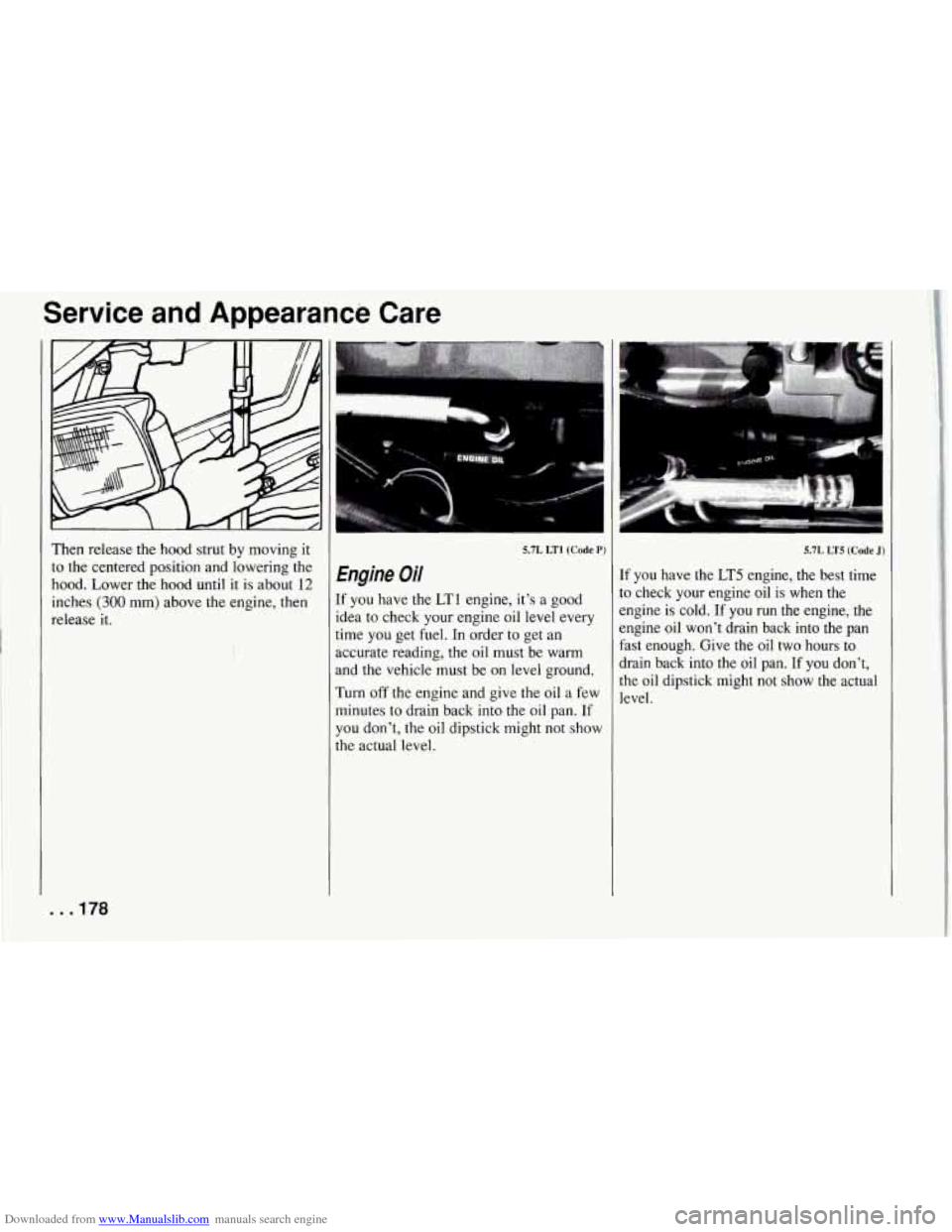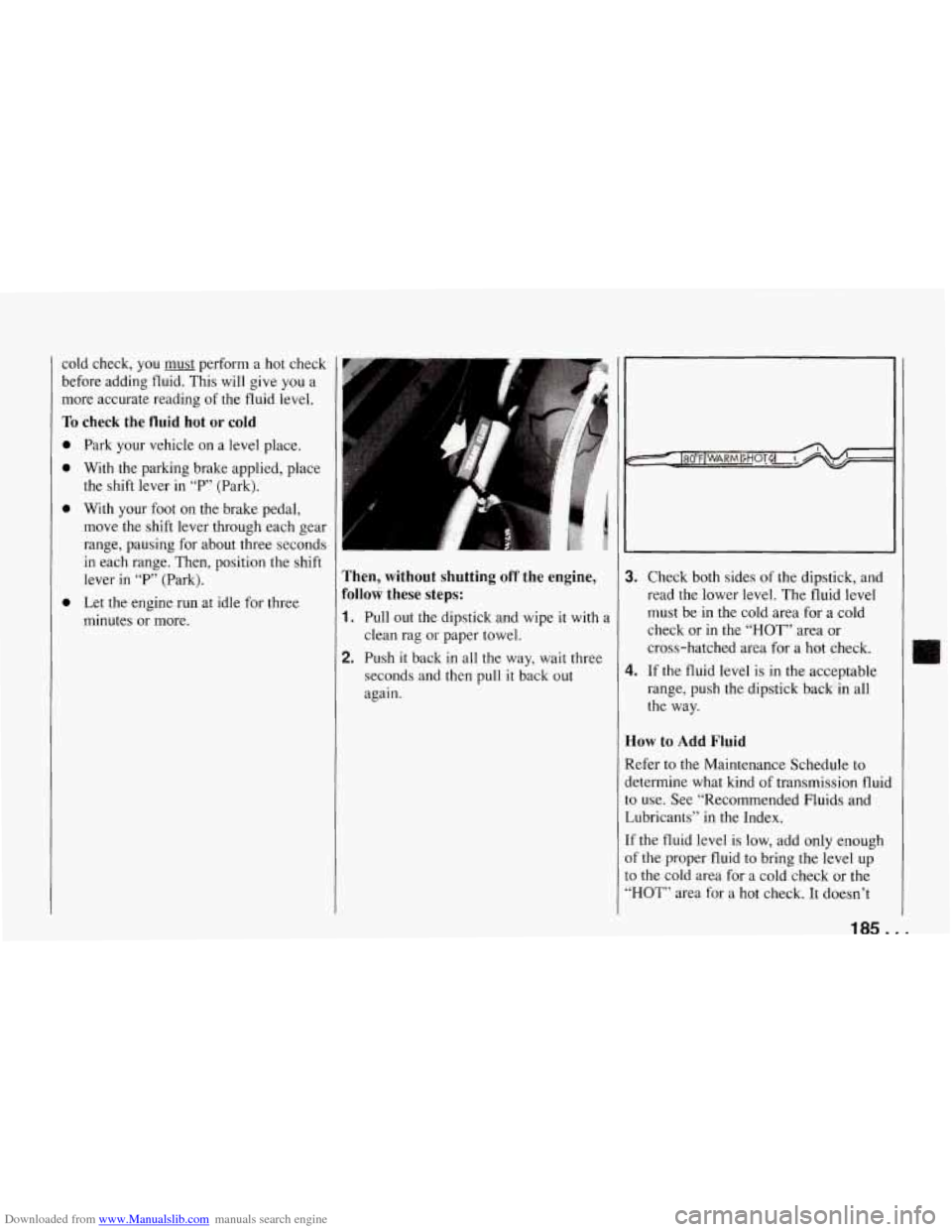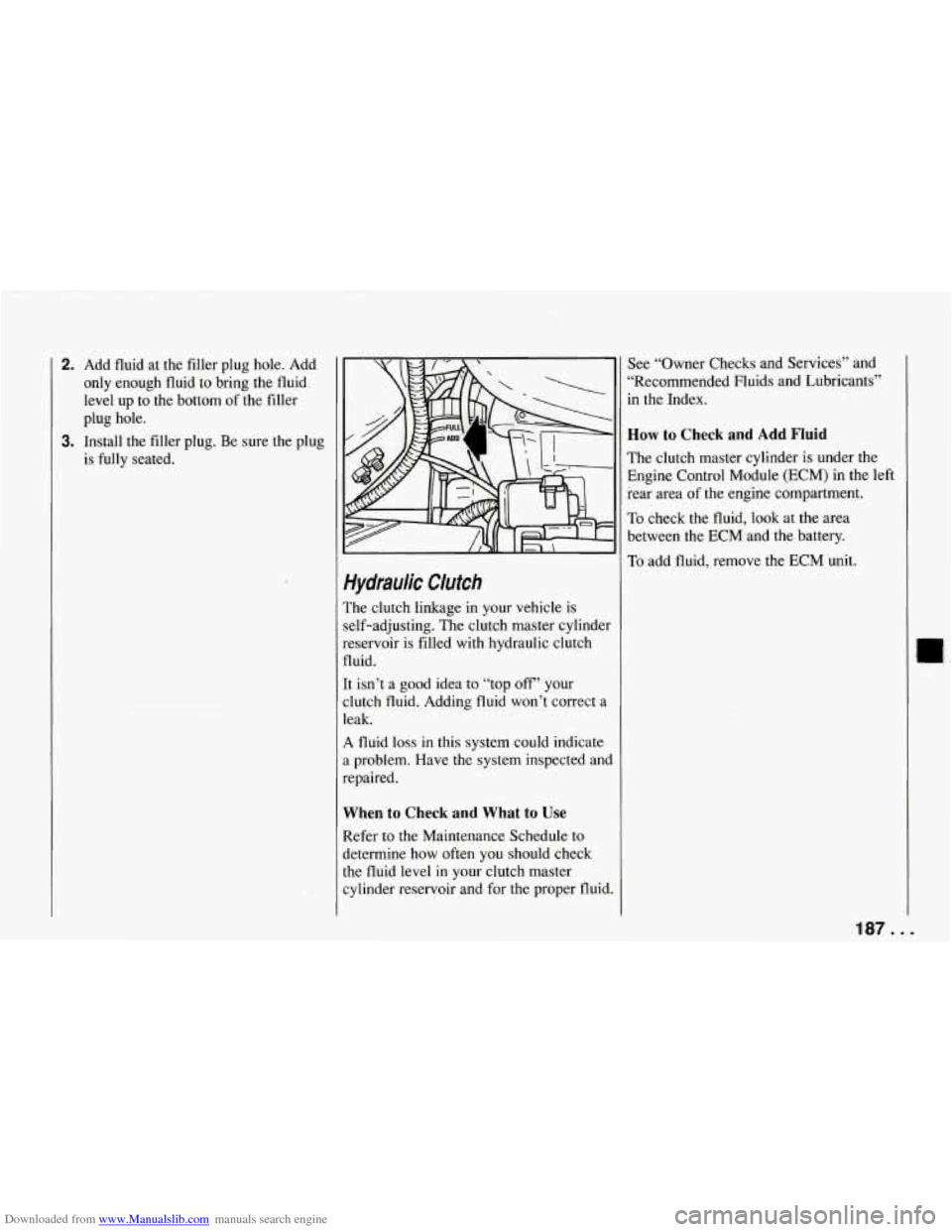1994 CHEVROLET CORVETTE check engine
[x] Cancel search: check enginePage 175 of 274

Downloaded from www.Manualslib.com manuals search engine Service and Appearance Care
Fuels in Foreign Countries
If you plan on driving in another country
outside the
U.S. or Canada, unleaded
fuel may be hard to find.
Do not use
leaded gasoline. If you use even one
tankful, your emission controls won’t
work well or at all. With continuous use,
spark plugs can get fouled, the exhaust
system can corrode, and your engine oil
can deteriorate quickly. Your vehicle’s
oxygen sensor will be damaged. All of
that means costly repairs that wouldn’t
be covered by your warranty.
To check on fuel availability, ask an auto
club, or contact a major oil company that
does business
in the country where you’ll
be driving.
You can also write us at the following
address for advice. Just tell
us where
you’re going and give your Vehicle
Identification Number (VIN).
General Motors Overseas Distribution
North American Export Sales
(NAES)
1908 Colonel Sam Drive
Oshawa, Ontario LlH 8P7
Corporation
. . .174
Filling
Your Tank
The cap is under a hinged door on the rear
of your vehicle. While
refueling, place the cap in the
indent to the left of the filler neck.
To take
off the cap, turn it slowly to the
left (counterclockwise).
Page 176 of 274

Downloaded from www.Manualslib.com manuals search engine Be careful not to spill gasoline. Clean
5asoline from painted suirfaces
as soon
1s possible. See “Cleaning the Outside
If Your Corvette’’ in the Index.
When you put the cap back on, turn it to
:he right until you hear at least three
:licks.
NOTICE:
If you need a new cap, be sure to
get the right type. Your dealer can
get one for you.
If you get the wrong
type, it may not fit or have proper
venting, and your fuel tank and
emissions system might be damaged.
I Checking Things under
the Hood
Hood Release
ro open the hood, first pull the handle
inside the vehicle.
L
Fhen go to the side of the vehicle and pull
~p on the rear edge of the hood, near the
windshield.
175 ...
Page 179 of 274

Downloaded from www.Manualslib.com manuals search engine Service and Appearance Care
Then release the hood strut by moving it
to the centered position and lowering the
hood. Lower the hood until it is about
12
inches (300 mm) above the engine, then
release it.
- - 178
I
!
5.7L LTl (Code P)
Engine Oil
If you have the LTl engine, it’s a good
idea to check your engine oil level every
time you get fuel. In order to get an
accurate reading, the oil must be warm
and the vehicle must be on level ground.
Turn off the engine and give the oil a few
minutes to drain back into the oil pan.
If
you don’t, the oil dipstick might not show
the actual level. d
tl
It
rain
le oi
:vel.
5.7L LT5 (Code J)
f you have the LT5 engine, the best time
3 check your engine oil is when the
ngine is cold. If you run the engine, the
ngine oil won’t drain back into the pan
ast enough. Give the oil two hours to
back into the oil pan. If you don’t,
1 dipstick might not show the actual
Page 180 of 274

Downloaded from www.Manualslib.com manuals search engine - ..f’.’.*.‘.*.I.
To Check Engine Oil
Pull out the dipstick and clean it with a
paper towel or cloth, then push it back
in
all the way. Remove it again, keeping the
tip lower.
5.7L LTl (Code E
When to Add Oil:
If the oil is at or below the “ADD’ mark,
you’ll need to add some oil. But you musl
use the right kind. This section explains
what kind
of oil to use. For crankcase
capacity, see “Capacities and
Specifications” in the Index.
NOTICE:
Don’t add too much oil. If your
engine has
so much oil that the oil
level gets above the upper mark that
shows the proper operating range,
your engine could be damaged.
5.7L LT5 (Code J)
Just fill it enough to put the level
somewhere
in the proper operating range.
Push the dipstick all the way back
in
when you’re through.
What Kind of Oil to Use
Look for two things:
GM4718M
The Corvette engine requires a special
oil meeting GM Standard GM47 18M.
Oils meeting this Standard may be
identified as synthetic. However, not
all SYNTHETIC oils will meet this
GM Standard. You should look
for
and use only an oil that meets GM
Standard GM47 18M.
179 ...
Page 185 of 274

Downloaded from www.Manualslib.com manuals search engine Service and Appearance Care
5.
0
0
Reverse the steps.
Align the tabs
to the slots in the
bottom of the assembly before you
replace it.
Install the short knob into the middle
hole first. Then install the longer
knobs into the outer holes.
Automatic Transmission Fluid
When to Check and Change
4 good time to check your automatic
:ransmission fluid level is when the
mgine oil is changed. Refer to the
Maintenance Schedule to determine when
co change your fluid. See “Scheduled
Maintenance Services” in the Index.
How to Check
Because this operation can be a little
iifficult, you may choose to have this
done at a Chevrolet dealership Service
Department.
[f you do it yourself, be sure to follow all
the instructions here, or you could get a
false reading on the dipstick.
NOTICE:
Too much or too little fluid can dam-
age your transmission.
Too much can
mean that some of the fluid could
come out and fall
on hot engine parts
or exhaust system, starting a fire. Be
sure to get an accurate reading if you
check your transmission fluid. Wait
at least 30 minutes before checking
the transmission fluid level if you have
been driving:
0 When outside temperatures are above
0 At high speed for quite a while.
0 In heavy traffic - especially in hot
To get the right reading, the fluid should
be at normal operating temperature, which is
180°F to 200°F (82°C to 93°C).
To check transmission fluid hot: Get
the vehicle warmed up by driving
about
15 miles (24 km) when outside
temperatures are above
50°F (10°C). If
it’s colder than
50°F (10°C)’ drive the
vehicle in
“D’ (Third Gear) until the
engine temperature gage moves and then
remains steady for ten minutes. Then follow the hot check procedures.
To check transmission fluid cold: A cold
check is made after the vehicle has been sitting for eight hours or more with the
engine
off and is used only as a reference.
Let the engine run at idle for five minutes
if outside temperatures are 50” F ( 1 OOC)
or more. If it’s colder than 50°F ( 10°C)’
you may have to idle the engine longer.
Should the fluid level be low during a
90°F (32°C).
weather.
. . .184
Page 186 of 274

Downloaded from www.Manualslib.com manuals search engine cold check, you must perform a hot check
before adding fluid. This will give you a
more accurate reading
of the fluid level.
To check the fluid hot or cold
0
Park your vehicle on a level place.
With the parking brake applied, place
the shift lever in “P” (Park).
With your foot
on the brake pedal,
move the shift lever through each gear
range, pausing for about three seconds
in each range. Then, position the shift
lever
in “P’ (Park).
Let the engine run at idle for three
minutes or more. Then, without shutting off the engine,
Follow these steps:
1. Pull out the dipstick and wipe it with a
clean rag or paper towel.
2. Push it back in all the way, wait three
seconds and then pull
it back out
again.
3. Check both sides of the dipstick, and
read the lower level. The fluid level
must be in the cold area for a cold
check or in the
“HOT” area or
cross-hatched area for a hot check.
range, push the dipstick back in all
the way.
4. If the fluid level is in the acceptable
How to Add Fluid
Refer to the Maintenance Schedule to
determine what kind of transmission fluid to use. See “Recommended Fluids and
Lubricants” in the Index.
If the fluid level
is low, add only enough
of the proper fluid to bring the level up
to the cold area for a cold check or the
“HOT” area for a hot check. It doesn’t
Page 187 of 274

Downloaded from www.Manualslib.com manuals search engine Service and Appearance Care
;ake much fluid, generally less than a pint.
Don’t overfill. We recommend you use
mly fluid labeled DEXRON@-111 or
DEXRON@-IIE, because fluids with that
label are made especially for your
automatic transmission. Dama e caused
by fluid other than DEXRON -111 or
DEXRON@-IIE is not covered by your
new vehicle warranty.
0 After adding fluid, recheck the fluid
level as described under “How to
Check.”
obtained, push the dipstick back in all
the way.
D
0 When the correct fluid level is
Manual Transmission Fluid
How to Check:
Because this operation can be difficult,
you may choose to have this done at a
Chevrolet dealership Service Department.
If you do it yourself, be sure to follow all
the instructions here, or you could get a
false reading.
. . .I86
NOTICE:
Too much or too little fluid can
damage your transmission.
Too much
can mean that some of the fluid could
come out and fall on hot engine parts
or exhaust system, starting a fire. Be
sure to get an accurate reading if
you
check your transmission fluid.
:heck the fluid level only when your
mgine is
off, the vehicle is parked on a
eve1 place and the transmission is cool
:nough for you to rest your fingers on
he transmission case. Then, follow these steps:
1. Remove the filler plug.
2. Check that the lubricant level is up to
the bottom of the filler plug hole.
3. If the fluid level is good, install the
plug and be sure it is fully seated. If
the fluid level is low, add more fluid
as described in the next steps.
How to Add Fluid:
Here’s how to add fluid. Refer to the
Maintenance Schedule to determine what
kind of fluid to use. See “Recommended
Fluids and Lubricants”
in the Index.
1. Remove the filler plug.
Page 188 of 274

Downloaded from www.Manualslib.com manuals search engine 2. Add fluid at the filler plug hole. Add only enough fluid to bring the fluid
level up to the bottom
of the filler
plug hole.
3. Install the filler plug. Be sure the plug
is fully seated.
Hydraulic Clutch
The clutch linkage in your vehicle is
self-adjusting. The clutch master cylinder
reservoir is filled with hydraulic clutch
fluid.
It isn’t a good idea to “top
off’ your
clutch fluid. Adding fluid won’t correct a
leak.
A fluid loss in this system could indicate
a problem. Have the system inspected and
repaired.
When to Check and What to Use
Refer to the Maintenance Schedule to
determine how often you should check
the fluid level in your clutch master
cylinder reservoir and for the proper fluid. See
“Owner Checks and Services’’ and
“Recommended Fluids and Lubricants”
in the Index.
How to Check and Add Fluid
The clutch master cylinder is under the
Engine Control Module
(ECM) in the left
rear area of the engine compartment.
To check the fluid, look at the area
between the
ECM and the battery.
To add fluid, remove the ECM unit.
187 ...